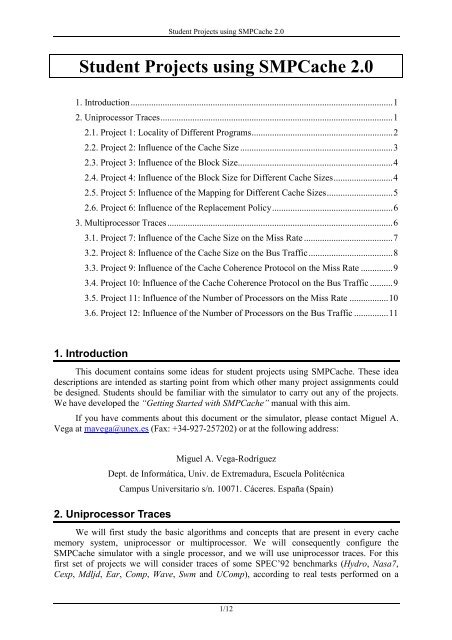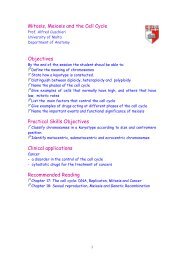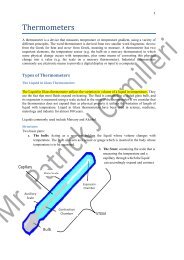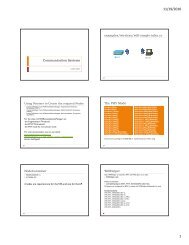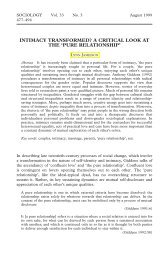Student Projects using SMPCache 2.0
Student Projects using SMPCache 2.0
Student Projects using SMPCache 2.0
Create successful ePaper yourself
Turn your PDF publications into a flip-book with our unique Google optimized e-Paper software.
<strong>Student</strong> <strong>Projects</strong> <strong>using</strong> <strong>SMPCache</strong> <strong>2.0</strong><br />
<strong>Student</strong> <strong>Projects</strong> <strong>using</strong> <strong>SMPCache</strong> <strong>2.0</strong><br />
1. Introduction...................................................................................................................1<br />
2. Uniprocessor Traces......................................................................................................1<br />
2.1. Project 1: Locality of Different Programs..............................................................2<br />
2.2. Project 2: Influence of the Cache Size ...................................................................3<br />
2.3. Project 3: Influence of the Block Size....................................................................4<br />
2.4. Project 4: Influence of the Block Size for Different Cache Sizes..........................4<br />
2.5. Project 5: Influence of the Mapping for Different Cache Sizes.............................5<br />
2.6. Project 6: Influence of the Replacement Policy.....................................................6<br />
3. Multiprocessor Traces...................................................................................................6<br />
3.1. Project 7: Influence of the Cache Size on the Miss Rate .......................................7<br />
3.2. Project 8: Influence of the Cache Size on the Bus Traffic.....................................8<br />
3.3. Project 9: Influence of the Cache Coherence Protocol on the Miss Rate ..............9<br />
3.4. Project 10: Influence of the Cache Coherence Protocol on the Bus Traffic ..........9<br />
3.5. Project 11: Influence of the Number of Processors on the Miss Rate .................10<br />
3.6. Project 12: Influence of the Number of Processors on the Bus Traffic ...............11<br />
1. Introduction<br />
This document contains some ideas for student projects <strong>using</strong> <strong>SMPCache</strong>. These idea<br />
descriptions are intended as starting point from which other many project assignments could<br />
be designed. <strong>Student</strong>s should be familiar with the simulator to carry out any of the projects.<br />
We have developed the “Getting Started with <strong>SMPCache</strong>” manual with this aim.<br />
If you have comments about this document or the simulator, please contact Miguel A.<br />
Vega at mavega@unex.es (Fax: +34-927-257202) or at the following address:<br />
Miguel A. Vega-Rodríguez<br />
Dept. de Informática, Univ. de Extremadura, Escuela Politécnica<br />
Campus Universitario s/n. 10071. Cáceres. España (Spain)<br />
2. Uniprocessor Traces<br />
We will first study the basic algorithms and concepts that are present in every cache<br />
memory system, uniprocessor or multiprocessor. We will consequently configure the<br />
<strong>SMPCache</strong> simulator with a single processor, and we will use uniprocessor traces. For this<br />
first set of projects we will consider traces of some SPEC’92 benchmarks (Hydro, Nasa7,<br />
Cexp, Mdljd, Ear, Comp, Wave, Swm and UComp), according to real tests performed on a<br />
1/12
<strong>Student</strong> <strong>Projects</strong> <strong>using</strong> <strong>SMPCache</strong> <strong>2.0</strong><br />
MIPS R2000 system. The traces used represent a wide variety of “real” application programs.<br />
These traces come from the Parallel Architecture Research Laboratory (PARL), New Mexico<br />
State University (NMSU), and they are available by anonymous ftp to tracebase.nmsu.edu.<br />
The traces had different formats, like Dinero or PDATS, and they have been changed to the<br />
<strong>SMPCache</strong> trace format (see Getting Started with <strong>SMPCache</strong> <strong>2.0</strong>, section 4). These traces,<br />
with the correct format for <strong>SMPCache</strong>, are included in your copy of the simulator. A<br />
summary of the traces is given in Table 1.<br />
Name Classification Language Comments<br />
Hydro Floating point --- Astrophysics: Hydrodynamic Naiver Stokes equations<br />
A collection of 7 kernels. For each kernel, the program<br />
Nasa7 Floating point Fortran generates its own input data, performs the kernel and<br />
compares the result against an expected result<br />
Cexp Integer C<br />
Portion of a Gnu C compiler that exhibits strong random<br />
behaviour<br />
Solves the equations of motion for a model of 500 atoms<br />
Mdljd Floating point Fortran<br />
interacting through the idealized Lennard-Jones<br />
potential. It is a numerical program that exhibits mixed<br />
looping and random behaviour<br />
Ear Floating point ---<br />
This trace, the same as the rest, was provided by Nadeem<br />
Malik of IBM<br />
Comp Integer C<br />
Uses Lempel-Ziv coding for<br />
Compresses an 1 MB file 20 times<br />
data compression.<br />
Wave Floating point Fortran<br />
Solves Maxwell’s equations and electromagnetic particle<br />
equations of motion<br />
Swm Floating point Fortran<br />
Solves a system of shallow water equations <strong>using</strong> finite<br />
difference approximations on a 256*256 grid<br />
UComp Integer C The uncompress version of Comp<br />
Table 1: Uniprocessor traces.<br />
���� Remember: All these uniprocessor projects can be performed in a similar way with<br />
multiprocessor traces.<br />
2.1. Project 1: Locality of Different Programs<br />
Purpose<br />
Show that the programs have different locality, and there are programs with “good” or<br />
“bad” locality.<br />
Development<br />
Configure a system with the following architectural characteristics:<br />
• Processors in SMP = 1.<br />
• Cache coherence protocol = MESI.<br />
• Scheme for bus arbitration = Random.<br />
• Word wide (bits) = 16.<br />
• Words by block = 16 (block size = 32 bytes).<br />
• Blocks in main memory = 8192 (main memory size = 256 KB).<br />
• Blocks in cache = 128 (cache size = 4 KB).<br />
2/12
• Mapping = Fully-Associative.<br />
• Replacement policy = LRU.<br />
<strong>Student</strong> <strong>Projects</strong> <strong>using</strong> <strong>SMPCache</strong> <strong>2.0</strong><br />
Obtain the miss rate <strong>using</strong> the memory traces: Hydro, Nasa7, Cexp, Mdljd, Ear, Comp,<br />
Wave, Swm and UComp (trace files with the same name and extension “.prg”).<br />
Do all the programs have the same locality grade? Which is the program with the best<br />
locality? And which does it have the worst? Do you think that the design of memory systems<br />
that exploit the locality of certain kind of programs (which will be the most common in a<br />
system) can increase the system performance? Why?<br />
During the development of the experiments, you can observe graphically how, in<br />
general, the miss rate decreases as the execution of the program goes forward. Why? Which is<br />
the reason?<br />
2.2. Project 2: Influence of the Cache Size<br />
Purpose<br />
Show the influence of the cache size on the miss rate.<br />
Development<br />
Configure a system with the following architectural characteristics:<br />
• Processors in SMP = 1.<br />
• Cache coherence protocol = MESI.<br />
• Scheme for bus arbitration = Random.<br />
• Word wide (bits) = 16.<br />
• Words by block = 16 (block size = 32 bytes).<br />
• Blocks in main memory = 8192 (main memory size = 256 KB).<br />
• Mapping = Fully-Associative.<br />
• Replacement policy = LRU.<br />
Configure the blocks in cache <strong>using</strong> the following configurations: 1 (cache size = 0,03<br />
KB), 2, 4, 8, 16, 32, 64, 128, 256, and 512 (cache size = 16 KB). For each of the<br />
configurations, obtain the miss rate <strong>using</strong> the trace files (extension “.prg”): Hydro, Nasa7,<br />
Cexp, Mdljd, Ear, Comp, Wave, Swm and UComp.<br />
Does the miss rate increase or decrease as the cache size increases? Why? Does this<br />
increment or decrement happen for all the benchmarks or does it depend on the different<br />
locality grades? What does it happen with the capacity and conflict (collision) misses when<br />
you enlarge the cache? Are there conflict misses in these experiments? Why?<br />
In these experiments, it may be observed that for great cache sizes, the miss rate is<br />
stabilized. Why? We can also see great differences of miss rate for a concrete increment of<br />
cache size. What do these great differences indicate? Do these great differences of miss rate<br />
appear at the same point for all the programs? Why?<br />
In conclusion, does the increase of cache size improve the system performance?<br />
3/12
<strong>Student</strong> <strong>Projects</strong> <strong>using</strong> <strong>SMPCache</strong> <strong>2.0</strong><br />
2.3. Project 3: Influence of the Block Size<br />
Purpose<br />
Study the influence of the block size on the miss rate.<br />
Development<br />
Configure a system with the following architectural characteristics:<br />
• Processors in SMP = 1.<br />
• Cache coherence protocol = MESI.<br />
• Scheme for bus arbitration = Random.<br />
• Word wide (bits) = 16.<br />
• Main memory size = 256 KB (the number of blocks in main memory will vary).<br />
• Cache size = 4 KB (the number of blocks in cache will vary).<br />
• Mapping = Fully-Associative.<br />
• Replacement policy = LRU.<br />
Configure the words by block <strong>using</strong> the following configurations: 4 (block size = 8<br />
bytes), 8, 16, 32, 64, 128, 256, 512, and 1024 (block size = 2048 bytes). For each of the<br />
configurations, obtain the miss rate <strong>using</strong> the trace files: Hydro, Nasa7, Cexp, Mdljd, Ear,<br />
Comp, Wave, Swm and UComp.<br />
Does the miss rate increase or decrease as the block size increases? Why? Does this<br />
increment or decrement happen for all the benchmarks or does it depend on the different<br />
locality grades? What does it happen with the compulsory misses when you enlarge the block<br />
size? What is the pollution point? Does it appear in these experiments?<br />
In conclusion, does the increase of block size improve the system performance?<br />
2.4. Project 4: Influence of the Block Size for Different Cache Sizes<br />
Purpose<br />
Show the influence of the block size on the miss rate, but in this case, for several cache<br />
sizes.<br />
Development<br />
Configure a system with the following architectural characteristics:<br />
• Processors in SMP = 1.<br />
• Cache coherence protocol = MESI.<br />
• Scheme for bus arbitration = Random.<br />
• Word wide (bits) = 32.<br />
• Main memory size = 1024 KB (the number of blocks in main memory will vary).<br />
• Mapping = Fully-Associative.<br />
• Replacement policy = LRU.<br />
4/12
<strong>Student</strong> <strong>Projects</strong> <strong>using</strong> <strong>SMPCache</strong> <strong>2.0</strong><br />
Configure the words by block <strong>using</strong> the following configurations: 8 (block size = 32<br />
bytes), 16, 32, 64, 128, 256, 512, and 1024 (block size = 4096 bytes). For each of the<br />
configurations of words by block, configure the number of blocks in cache in order to get the<br />
following cache sizes: 4 KB, 8 KB, 16 KB, and 32 KB. For each configuration obtain the<br />
miss rate <strong>using</strong> the memory trace: Ear.<br />
We are first going to ask you the same questions as in the previous project: Does the<br />
miss rate increase or decrease as the block size increases? Why? What does it happen with the<br />
compulsory misses when you enlarge the block size? Does the pollution point appear in these<br />
experiments?<br />
Does the influence of the pollution point increase or decrease as the cache size<br />
increases? Why?<br />
2.5. Project 5: Influence of the Mapping for Different Cache Sizes<br />
Purpose<br />
Analyse the influence of the mapping on the miss rate for several cache sizes.<br />
Development<br />
Configure a system with the following architectural characteristics:<br />
• Processors in SMP = 1.<br />
• Cache coherence protocol = MESI.<br />
• Scheme for bus arbitration = Random.<br />
• Word wide (bits) = 32.<br />
• Words by block = 64 (block size = 256 bytes).<br />
• Blocks in main memory = 4096 (main memory size = 1024 KB).<br />
• Replacement policy = LRU.<br />
Configure the mapping <strong>using</strong> the following configurations: Direct, two-way set<br />
associative, four-way set associative, eight-way set associative, and fully-associative<br />
(remember: Number_of_ways = Number_of_blocks_in_cache / Number_of_cache_sets). For<br />
each of the configurations of mapping, configure the number of blocks in cache in order to get<br />
the following cache sizes: 4 KB (16 blocks in cache), 8 KB, 16 KB, and 32 KB (128 blocks in<br />
cache). For each configuration obtain the miss rate <strong>using</strong> the memory trace: Ear.<br />
Does the miss rate increase or decrease as the associativity increases? Why? What does<br />
it happen with the conflict misses when you enlarge the associativity grade?<br />
Does the influence of the associativity grade increase or decrease as the cache size<br />
increases? Why?<br />
In conclusion, does the increase of associativity improve the system performance? If the<br />
answer is yes, in general, which is the step with more benefits: from direct to 2-way, from 2way<br />
to 4-way, from 4-way to 8-way, or from 8-way to fully-associative?<br />
5/12
<strong>Student</strong> <strong>Projects</strong> <strong>using</strong> <strong>SMPCache</strong> <strong>2.0</strong><br />
2.6. Project 6: Influence of the Replacement Policy<br />
Purpose<br />
Show the influence of the replacement policy on the miss rate.<br />
Development<br />
Configure a system with the following architectural characteristics:<br />
• Processors in SMP = 1.<br />
• Cache coherence protocol = MESI.<br />
• Scheme for bus arbitration = Random.<br />
• Word wide (bits) = 16.<br />
• Words by block = 16 (block size = 32 bytes).<br />
• Blocks in main memory = 8192 (main memory size = 256 KB).<br />
• Blocks in cache = 128 (cache size = 4 KB).<br />
• Mapping = 8-way set-associative (cache sets = 16).<br />
Configure the replacement policy <strong>using</strong> the following configurations: Random, LRU,<br />
LFU, and FIFO. For each of the configurations, obtain the miss rate <strong>using</strong> the trace files<br />
(extension “.prg”): Hydro, Nasa7, Cexp, Mdljd, Ear, Comp, Wave, Swm and UComp.<br />
In general, which is the replacement policy with the best miss rate? And which does it<br />
have the worst? Do the benefits of LFU and FIFO policies happen for all the benchmarks or<br />
do they depend on the different locality grades?<br />
For a direct-mapped cache, would you expect the results for the different replacement<br />
policies to be different? Why or why not?<br />
In conclusion, does the use of a concrete replacement policy improve the system<br />
performance? If the answer is yes, in general, which is the step with more benefits: from<br />
Random to LRU, from Random to LFU, or from Random to FIFO? Why (consider the<br />
cost/performance aspect)?<br />
3. Multiprocessor Traces<br />
After analysing the basic algorithms and concepts that are present in every cache<br />
memory system (uniprocessor or multiprocessor), we study some theoretical issues related<br />
with multiprocessor systems. In these projects, we will consequently configure the <strong>SMPCache</strong><br />
simulator with more than one processor, and we will use multiprocessor traces with tens of<br />
millions of memory accesses (references) for four benchmarks (FFT, Simple, Speech and<br />
Weather). These traces were provided by David Chaiken (then of MIT) for NMSU PARL,<br />
and they are available by anonymous ftp to tracebase.nmsu.edu. The traces represent several<br />
real parallel applications (FFT, Simple and Weather traces were generated <strong>using</strong> the postmortem<br />
scheme implemented by Mathews Cherian with Kimming So at IBM). The traces had<br />
different formats, like the canonical format for multiprocessor traces developed by Anant<br />
Agarwal, and they have been changed to the <strong>SMPCache</strong> trace format (see Getting Started with<br />
<strong>SMPCache</strong> <strong>2.0</strong>, section 4). These traces, with the correct format for <strong>SMPCache</strong>, can be<br />
obtained at the address http://atc.unex.es/mavega/<strong>SMPCache</strong>/<strong>SMPCache</strong>English.htm or<br />
http://atc.unex.es/smpcache. A summary of the traces is shown in Table 2.<br />
6/12
<strong>Student</strong> <strong>Projects</strong> <strong>using</strong> <strong>SMPCache</strong> <strong>2.0</strong><br />
Name References Language Comments<br />
FFT 7,451,717 Fortran Parallel application that simulates the fluid dynamics with FFT<br />
Simple 27,030,092 Fortran Parallel version of the SIMPLE application<br />
Speech 11,771,664 ---<br />
Kirk Johnson and David Kranz (both at MIT) are responsible<br />
Weather 31,764,036 Fortran<br />
Table 2: Multiprocessor traces.<br />
for this trace<br />
Parallel version of the WEATHER application, which is used<br />
for weather forecasting. The serial version is from NASA<br />
Space Flight Center, Greenbelt, Md.<br />
3.1. Project 7: Influence of the Cache Size on the Miss Rate<br />
Purpose<br />
Study the influence of the cache size on the miss rate during the execution of a parallel<br />
program in a SMP (symmetric multiprocessor). This project also allows us to show that all the<br />
previous uniprocessor projects can be performed in a similar way for multiprocessor systems<br />
(multiprocessor traces).<br />
Development<br />
Configure a system with the following architectural characteristics:<br />
• Processors in SMP = 8.<br />
• Cache coherence protocol = MESI.<br />
• Scheme for bus arbitration = LRU.<br />
• Word wide (bits) = 16.<br />
• Words by block = 32 (block size = 64 bytes).<br />
• Blocks in main memory = 524288 (main memory size = 32 MB).<br />
• Mapping = Set-Associative.<br />
• Cache sets = They will vary depending on the number of blocks in cache, but you<br />
must always have four-way set associative caches (remember: Number_of_ways =<br />
Number_of_blocks_in_cache / Number_of_cache_sets).<br />
• Replacement policy = LRU.<br />
Configure the blocks in cache <strong>using</strong> the following configurations: 16 (cache size = 1<br />
KB), 32, 64, 128, 256, 512, 1024, and 2048 (cache size = 128 KB). For each of the<br />
configurations, obtain the global miss rate for the system <strong>using</strong> the trace files: FFT, Simple,<br />
Speech and Weather.<br />
Does the global miss rate increase or decrease as the cache size increases? Why? Does<br />
this increment or decrement happen for all the benchmarks or does it depend on the different<br />
locality grades? What does it happen with the capacity and conflict (collision) misses when<br />
you enlarge the caches? And, what does it happen with the compulsory and coherence misses<br />
when you enlarge the caches? Are there conflict misses in these experiments? Why?<br />
In these experiments, it may be observed that for great cache sizes, the miss rate is<br />
stabilized. Why? We can also see great differences of miss rate for a concrete increment of<br />
cache size. What do these great differences indicate? Do these great differences of miss rate<br />
appear at the same point for all the programs? Why?<br />
7/12
<strong>Student</strong> <strong>Projects</strong> <strong>using</strong> <strong>SMPCache</strong> <strong>2.0</strong><br />
Compare these results with the results obtained in the project 2 (section 2.2). You can<br />
observe that the miss rates are higher for multiprocessor traces than for uniprocessor traces.<br />
Do you think that, in general, parallel programs exhibit more or less spatial and temporal<br />
locality than serial programs? Why? Is it due to the shared data?<br />
In conclusion, does the increase of cache size improve the multiprocessor system<br />
performance?<br />
3.2. Project 8: Influence of the Cache Size on the Bus Traffic<br />
Purpose<br />
Show the influence of the cache size on the bus traffic during the execution of a parallel<br />
program in a SMP.<br />
Development<br />
Configure a system with the following architectural characteristics:<br />
• Processors in SMP = 8.<br />
• Cache coherence protocol = MESI.<br />
• Scheme for bus arbitration = LRU.<br />
• Word wide (bits) = 16.<br />
• Words by block = 32 (block size = 64 bytes).<br />
• Blocks in main memory = 524288 (main memory size = 32 MB).<br />
• Mapping = Set-Associative.<br />
• Cache sets = They will vary depending on the number of blocks in cache, but you<br />
must always have four-way set associative caches (remember: Number_of_ways =<br />
Number_of_blocks_in_cache / Number_of_cache_sets).<br />
• Replacement policy = LRU.<br />
Configure the blocks in cache <strong>using</strong> the following configurations: 16 (cache size = 1<br />
KB), 32, 64, 128, 256, 512, 1024, and 2048 (cache size = 128 KB). For each of the<br />
configurations, obtain the bus traffic (in bytes per memory access) for the system <strong>using</strong> the<br />
trace files: FFT, Simple, Speech and Weather. In order to compute the bus traffic, assume that<br />
cache block transfers move 64 bytes (the block size) on the bus data lines, and that each bus<br />
transaction involves six bytes of command and address on the bus address lines. Therefore,<br />
you can compute the address traffic (including command) by multiplying the obtained bus<br />
transactions by the traffic per transaction (6 bytes). In the same way, you can compute the<br />
data traffic by multiplying the number of block transfers by the traffic per transfer (64 bytes).<br />
The total bus traffic, in bytes per memory access, will be the addition of these two quantities<br />
divided by the number of memory accesses (references) in the trace (see Table 2).<br />
Does the global bus traffic increase or decrease as the cache size increases? Why (give<br />
two reasons, one for the data traffic and another for the address+command bus traffic)? Does<br />
this increment or decrement happen for all the benchmarks?<br />
In these experiments, it may be observed that for great cache sizes, the bus traffic is<br />
stabilized. Why? We can also see great differences of bus traffic for a concrete increment of<br />
cache size. What do these great differences indicate? Do these great differences of bus traffic<br />
appear at the same point for all the programs? Why?<br />
8/12
<strong>Student</strong> <strong>Projects</strong> <strong>using</strong> <strong>SMPCache</strong> <strong>2.0</strong><br />
In conclusion, does the increase of cache size improve the multiprocessor system<br />
performance? Are the conclusions you obtain similar to the previous ones for the miss rate<br />
(project 7)?<br />
3.3. Project 9: Influence of the Cache Coherence Protocol on the Miss Rate<br />
Purpose<br />
Study the influence of the cache coherence protocol on the miss rate during the<br />
execution of a parallel program in a symmetric multiprocessor.<br />
Development<br />
Configure a system with the following architectural characteristics:<br />
• Processors in SMP = 8.<br />
• Scheme for bus arbitration = LRU.<br />
• Word wide (bits) = 16.<br />
• Words by block = 32 (block size = 64 bytes).<br />
• Blocks in main memory = 524288 (main memory size = 32 MB).<br />
• Blocks in cache = 256 (cache size = 16 KB).<br />
• Mapping = Set-Associative.<br />
• Cache sets = 64 (four-way set associative caches).<br />
• Replacement policy = LRU.<br />
Configure the cache coherence protocol <strong>using</strong> the following configurations: MSI,<br />
MESI, and DRAGON. For each of the configurations, obtain the global miss rate for the<br />
system <strong>using</strong> the memory traces: FFT, Simple, Speech and Weather.<br />
Do all the protocols have the same miss rate? Which is the coherence protocol with the<br />
best miss rate? And which does it have the worst? In particular, is the miss rate the same for<br />
the MSI and MESI protocols? Why?<br />
Do you observe any difference between the update-based protocol and the invalidationbased<br />
protocols? Which? Why? Are the coherence misses the same for these two kinds of<br />
protocols?<br />
Do you think that the results and conclusions obtained with these experiments are of<br />
general application or they may change depending on the used benchmarks?<br />
In conclusion, does the use of a concrete cache coherence protocol improve the<br />
multiprocessor system performance? Why?<br />
3.4. Project 10: Influence of the Cache Coherence Protocol on the Bus Traffic<br />
Purpose<br />
Analyse the influence of the cache coherence protocol on the bus traffic during the<br />
execution of a parallel program in a SMP.<br />
9/12
Development<br />
<strong>Student</strong> <strong>Projects</strong> <strong>using</strong> <strong>SMPCache</strong> <strong>2.0</strong><br />
Configure a system with the following architectural characteristics:<br />
• Processors in SMP = 8.<br />
• Scheme for bus arbitration = LRU.<br />
• Word wide (bits) = 16.<br />
• Words by block = 32 (block size = 64 bytes).<br />
• Blocks in main memory = 524288 (main memory size = 32 MB).<br />
• Blocks in cache = 256 (cache size = 16 KB).<br />
• Mapping = Set-Associative.<br />
• Cache sets = 64 (four-way set associative caches).<br />
• Replacement policy = LRU.<br />
Configure the cache coherence protocol <strong>using</strong> the following configurations: MSI,<br />
MESI, and DRAGON. For each of the configurations, obtain the bus traffic (in bytes per<br />
memory access) for the system <strong>using</strong> the trace files: FFT, Simple, Speech and Weather. In<br />
order to compute the bus traffic, assume that cache block transfers move 64 bytes (the block<br />
size) on the bus data lines, and that each bus transaction involves six bytes of command and<br />
address on the bus address lines. Therefore, you can compute the address traffic (including<br />
command) by multiplying the obtained bus transactions by the traffic per transaction (6<br />
bytes). In the same way, you can compute the data traffic by multiplying the number of block<br />
transfers by the traffic per transfer (64 bytes). The total bus traffic, in bytes per memory<br />
access, will be the addition of these two quantities divided by the number of memory accesses<br />
(references) in the trace (see Table 2).<br />
Do all the protocols have the same bus traffic? Which is the coherence protocol with the<br />
best bus traffic? And which does it have the worst? In particular, is the bus traffic the same for<br />
the MSI and MESI protocols? Why (for this answer, remember how the miss rate was for<br />
these two protocols –project 9)?<br />
Do you observe any difference between the update-based protocol and the invalidationbased<br />
protocols? Which? Why (give at least two reasons)?<br />
Do you think that the results and conclusions obtained with these experiments are of<br />
general application or they may change depending on the used benchmarks? Indicate other<br />
scenario in which the invalidation protocol does much better than the update protocol.<br />
In conclusion, does the use of a concrete cache coherence protocol improve the<br />
multiprocessor system performance? Why? Are the conclusions you obtain similar to the<br />
previous ones for the miss rate (project 9)?<br />
3.5. Project 11: Influence of the Number of Processors on the Miss Rate<br />
Purpose<br />
Study the influence of the number of processors on the miss rate during the execution of<br />
a parallel program in a symmetric multiprocessor.<br />
Development<br />
Configure a system with the following architectural characteristics:<br />
10/12
<strong>Student</strong> <strong>Projects</strong> <strong>using</strong> <strong>SMPCache</strong> <strong>2.0</strong><br />
• Cache coherence protocol = MESI.<br />
• Scheme for bus arbitration = LRU.<br />
• Word wide (bits) = 16.<br />
• Words by block = 32 (block size = 64 bytes).<br />
• Blocks in main memory = 524288 (main memory size = 32 MB).<br />
• Blocks in cache = 256 (cache size = 16 KB).<br />
• Mapping = Set-Associative.<br />
• Cache sets = 64 (four-way set associative caches).<br />
• Replacement policy = LRU.<br />
Configure the number of processors in the SMP <strong>using</strong> the following configurations: 1,<br />
2, 4, and 8. For each of the configurations, obtain the global miss rate for the system <strong>using</strong> the<br />
three traces that were generated by the post-mortem scheme: FFT, Simple and Weather.<br />
Does the global miss rate increase or decrease as the number of processors increases?<br />
Why? Does this increment or decrement happen for all the benchmarks or does it depend on<br />
the different locality grades, shared data,...? What does it happen with the capacity and<br />
coherence misses when you enlarge the number of processors? Are there conflict misses in<br />
these experiments? Why?<br />
Do you think that the results and conclusions obtained with these experiments are of<br />
general application or they may change depending on the cache coherence protocol? Why?<br />
In conclusion, does the increase of the number of processors improve the multiprocessor<br />
system performance? Why and in what sense?<br />
3.6. Project 12: Influence of the Number of Processors on the Bus Traffic<br />
Purpose<br />
Evaluate the influence of the number of processors on the bus traffic during the<br />
execution of a parallel program in a symmetric multiprocessor.<br />
Development<br />
Configure a system with the following architectural characteristics:<br />
• Cache coherence protocol = MESI.<br />
• Scheme for bus arbitration = LRU.<br />
• Word wide (bits) = 16.<br />
• Words by block = 32 (block size = 64 bytes).<br />
• Blocks in main memory = 524288 (main memory size = 32 MB).<br />
• Blocks in cache = 256 (cache size = 16 KB).<br />
• Mapping = Set-Associative.<br />
• Cache sets = 64 (four-way set associative caches).<br />
• Replacement policy = LRU.<br />
Configure the number of processors in the SMP <strong>using</strong> the following configurations: 1,<br />
2, 4, and 8. For each of the configurations, obtain the bus traffic (in bytes per memory access)<br />
for the system <strong>using</strong> the three traces that were generated by the post-mortem scheme: FFT,<br />
Simple and Weather. Remember: In order to compute the bus traffic, assume that cache block<br />
11/12
<strong>Student</strong> <strong>Projects</strong> <strong>using</strong> <strong>SMPCache</strong> <strong>2.0</strong><br />
transfers move 64 bytes (the block size) on the bus data lines, and that each bus transaction<br />
involves six bytes of command and address on the bus address lines. Therefore, you can<br />
compute the address traffic (including command) by multiplying the obtained bus transactions<br />
by the traffic per transaction (6 bytes). In the same way, you can compute the data traffic by<br />
multiplying the number of block transfers by the traffic per transfer (64 bytes). The total bus<br />
traffic, in bytes per memory access, will be the addition of these two quantities divided by the<br />
number of memory accesses (references) in the trace (see Table 2).<br />
Does the global bus traffic increase or decrease as the number of processors increases?<br />
Why (give two reasons, one for the data traffic and another for the address+command bus<br />
traffic)? Does this increment or decrement happen for all the benchmarks or does it depend on<br />
the different locality grades, shared data,...?<br />
In general, which is the step with more bus traffic: from 1 to 2 processors, from 2 to 4<br />
processors, or from 4 to 8 processors? Why?<br />
Do you think that the results and conclusions obtained with these experiments are of<br />
general application or they may change depending on the cache coherence protocol? Why?<br />
Change the results obtained with these experiments in order to measure the bus traffic in<br />
bytes per instruction (you must divide by the number of instruction captures -not memory<br />
accesses- in the traces). Supposing that these applications run at a sustained 100 MIPS per<br />
processor (and they are integer-intensive applications), what is the address and data bus<br />
bandwidth requirement for each application and configuration of the number of processors?<br />
The computation in the question above gives the average bandwidth requirement under<br />
the assumption that the bus bandwidth is enough to allow the processors to execute at full<br />
speed. This computation provides a useful basis for sizing the system. For example, on a<br />
machine with 4.8 GB/s of data bandwidth, how many processors will the bus be able to<br />
support without saturating for each benchmark? Remember: If the bandwidth is not sufficient<br />
to support the application, the application will slow down.<br />
In conclusion, does the increase of the number of processors improve the multiprocessor<br />
system performance? Why and in what sense? Are the conclusions you obtain similar to the<br />
previous ones for the miss rate (project 11)?<br />
12/12


